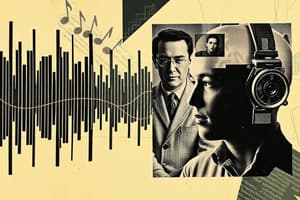Podcast
Questions and Answers
What does a compression ratio of 2:1 indicate?
What does a compression ratio of 2:1 indicate?
- The signal is fully compressed.
- No compression is applied.
- 1dB output for every 2dB above threshold. (correct)
- 1dB output for every 1dB above threshold.
What is the key difference between a Hard Knee and a Soft Knee in compression?
What is the key difference between a Hard Knee and a Soft Knee in compression?
- Both Hard Knee and Soft Knee apply compression at the same rate but differ in output.
- Hard Knee applies compression gradually, while Soft Knee applies compression immediately.
- Hard Knee leads to audio distortion, whereas Soft Knee does not.
- Hard Knee applies no compression until a certain point, while Soft Knee applies gradual compression. (correct)
Which term describes how quickly a compressor stops applying compression once the signal falls below the threshold?
Which term describes how quickly a compressor stops applying compression once the signal falls below the threshold?
- Sustain Time
- Decay Time
- Attack Time
- Release Time (correct)
According to Roger Caillos, which of the following is NOT a characteristic of a game?
According to Roger Caillos, which of the following is NOT a characteristic of a game?
Which statement accurately reflects the relationship between games and narratives?
Which statement accurately reflects the relationship between games and narratives?
What does Hertz (Hz) measure in relation to sound waves?
What does Hertz (Hz) measure in relation to sound waves?
Which frequency range is typical for the human voice?
Which frequency range is typical for the human voice?
What is the primary function of a compressor in audio processing?
What is the primary function of a compressor in audio processing?
Which decibel level represents the threshold of human hearing?
Which decibel level represents the threshold of human hearing?
How does increased frequency affect the pitch of a sound?
How does increased frequency affect the pitch of a sound?
Flashcards
Hertz (Hz)
Hertz (Hz)
The unit of measurement for the frequency of sound waves. One Hertz equals one cycle per second.
Frequency
Frequency
The rate at which a sound wave oscillates or vibrates per second. Higher frequency means higher pitch.
Dynamic Range
Dynamic Range
The difference between the loudest and quietest sounds in a recording. A wider range allows for more detail and dynamic variation.
Equalization (EQ)
Equalization (EQ)
Signup and view all the flashcards
Compression
Compression
Signup and view all the flashcards
Compression Ratio
Compression Ratio
Signup and view all the flashcards
Attack Time
Attack Time
Signup and view all the flashcards
Release Time
Release Time
Signup and view all the flashcards
Threshold
Threshold
Signup and view all the flashcards
Soft Knee
Soft Knee
Signup and view all the flashcards
Study Notes
Audio Communication
- Hertz (Hz) is a unit of frequency, measuring cycles per second. One Hz equals one cycle per second.
- Frequency refers to the number of times a sound wave oscillates per second, measured in Hz. Higher frequency equals a higher pitch.
- Standard human hearing range is 20Hz to 20,000Hz. The human voice range is 80Hz to 4,000Hz (higher for females). CD quality audio is 44,100Hz.
- Decibels (dB) measure sound wave amplitude (loudness). Higher amplitude equals louder volume.
- 0dB is the threshold of human hearing.
- 96dB is a common 16-bit recording level.
- 144dB is associated with a 24-bit recording level.
- Dynamic range is the difference between the softest and loudest sounds in a recording.
- Gain is the input signal loudness, controlled by the interface.
- Level refers to the loudness in a mixer relative to unity gain
- Volume is the output signal loudness.
- Equalization (EQ) adjusts the balance of frequency components in an audio signal. This allows boosting or cutting specific frequencies.
Compression
- Compression controls sound dynamic range by reducing the difference between loud and soft sounds.
- Compression needs to start working at a threshold level.
- The compression ratio indicates how much the output changes for each dB above the threshold.
- A ratio of 1:1 means no compression.
- A ratio of 2:1 means 1dB of output for every 2dB of input above the threshold.
- "Hard Knee" compression kicks in sharply once the threshold is reached.
- "Soft Knee" compression gradually increases as the input level goes above the threshold.
- Attack time is how quickly the compressor reduces the input signal above the threshold.
- Release time is how quickly the compressor returns to normal once the signal falls below the threshold.
Digital Audio Terms
- DAW: Digital Audio Workstation
- MIDI: Musical Instrument Digital Interface
- AD/DA: Analog to Digital/Digital to Analog conversion
- ADSR: Attack, Decay, Sustain, Release (describes the envelope of audio signals)
Digital Games
- Games share family resemblances.
- "A game is voluntary activity, separate in time and space, uncertain, unproductive, governed by rules, contains make-believe." (Roger Caillois)
- Digital games can or can not have a clear win condition. Animal Crossing doesn't have a clear objective, while Tetris does.
- Games have components: material, objects, systems, rules, player experience.
Studying That Suits You
Use AI to generate personalized quizzes and flashcards to suit your learning preferences.



